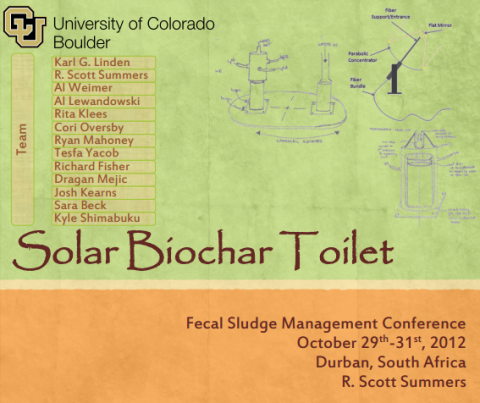Sol-char toilet: Using concentrated solar energy to stabilize fecal waste and produce a valuable soil amendment - Various documents on results from research grant
Linden, K. (2013)

Published in: 2013
Publisher:
University of Colorado, Boulder, USA
Author:
Linden, K.
Uploaded by:
SuSanA secretariat
Partner profile:
common upload
10763 Views
678 Downloads
Content - Summary
This library entry contains background documents for a grant that Karl Linden is leading and which is funded by the Bill and Melinda Gates Foundation.
Further information and a discussion is available on the SuSanA discussion Forum, see link below.
Project Description:
Last September, our team here at the University of Colorado, Boulder took on the BMGF challenge to reinvent the toilet with a novel approach that utilizes concentrated solar energy to safely and efficiently char fecal waste without the need for intensive pre-drying.
As a quick overview, our toilet – the Sol-Char Toilet – is a waterless, self-contained toilet that functions off-the-grid. Concentrated sunlight is delivered to fiber optic bundles located at the focus of parabolic concentrators (see Concept Sketch). The fiber optic cables are fed to the reaction compartment of the Sol-Char where the various individual cables are terminated at an outer or “solar” lid positioned over the waste collection container. The innovative transmission of concentrated solar power illuminates the inner collection container and disinfects the waste though conduction, convection, and radiation heat transfer. The reaction compartment comprises two or more containers that are alternated between “collection” and “reaction” modes via a simple carousel system that can be automated (powered with photovoltaic energy) or manually controlled. The reactor is designed to achieve high temperatures (300oC to 750oC) and produces a safe and useable product.
Research Goal:
Our goal during this phase 1 of research is to develop a functioning toilet prototype that will provide a scientific basis for utilizing concentrated solar energy to safely disinfect and transform human waste into valuable end products (such as char for agricultural soil application).
On-going research activities include:
• Solar collection and transmission optimization
• Reactor modeling and fabrication
• Char product evaluation and testing
o Hydrothermal carbonization (HTC) and dry pyrolysis chars will be compared
o Dry pyrolysis will also be evaluated with mixed waste and urine diversion to determine the best utilization of nutrients
o Adsorption studies will be conducted in the liquid and gas phase to determine if the char can be further enriched with NPK
• Means for odor control, gas utilization, and final product storage
• User interface and safety features
Our prototype development is underway and we are excited to further advance this technology. We welcome your feedback and comments!
Further authors: Linden, K. G., Summers, R. S., Weimer, A., Lewandowski, A., Klees, R., Oversby, C., Mahoney, R., Yacob, T., Fisher, R., Mejic, D., Kearns, J., Beck, S., Shimabuku, K.
+++++++++++
Documents available for download below:
1 - Solar biochar toilet (presentation at FSM2 Conference in Durban, South Africa, Oct. 2012)
2 - Solar biochar toilet (paper at FSM2 Conference in Durban, South Africa, Oct. 2012)
3 - Short presentation on biochar toilet at webinar, by Chip Fisher and Ryan Mahony (Nov. 2013)
4 - Applications of concentrated solar-energy in innovative sanitation solutions (presentation at FSM3 Conference in Hanoi, Vietnam, Jan. 2015)
Bibliographic information
Linden, K. (2013). Sol-char toilet: Using concentrated solar energy to stabilize fecal waste and produce a valuable soil amendment - Various documents on results from research grant. University of Colorado, Boulder, USA
Filter tags
English Fundamental research and engineering North America














